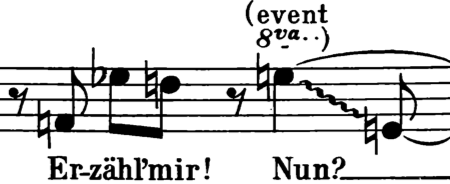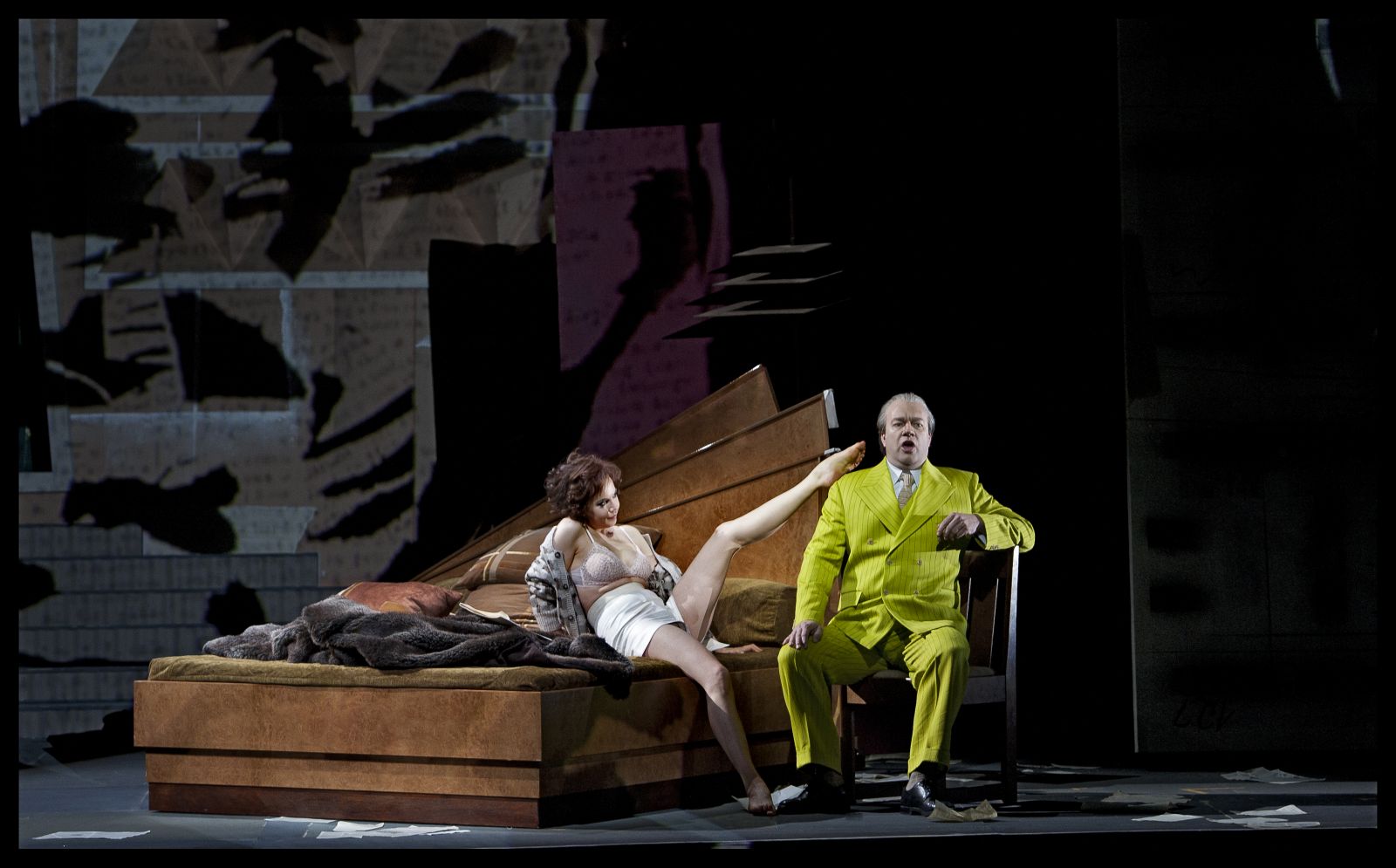© Clärchen & Matthias Baus
Amsterdam, 1 juni 2015
Boring ‘Lulu’ at DNO
MUSICAL
1. Is DNO true to the music or are there changes?
– De Nationale Opera (DNO) brings the opera ‘Lulu’ by Alban Berg (1885-1935) in its full version. Berg died before he could complete the opera and the composer Friedrich Cerha finished the third and final act. DNO pretends as if this performance of ‘Lulu’ is the “national” premiere, but nothing could be further from the truth. *****
2. Are the singers suited for their roles?
 – The soloists are good, but not incredibly good. Mojca Erdmann as Lulu (also in the Berliner Staatsoper, 2012 and 2015) sings all the notes, including the high E in the second scene of the first Act, which haveprobably never before been sung before. But she doesn’t sound sensual and is too adult to be credibly ignorant and indecent. Johan Reuter as Dr. Schön/Jack the Ripper (also in Copenhagen, 2010) with his impressive baritone is the star of the cast and also William Burden is a fantastic Der Maler/Ein Neger. He had better traded places with Daniel Brenna, who as Alwa cannot cope his monologue in the second act. Franz Grundheber as Schigolch (also in Salzburg and Liceu, 2010 and L’Opéra, 2011) and Jennifer Larmore as Gräfin Geschwitz (also in L’Opéra, 2011) are a great couple. In short, a listenable cast, you get when casting managers paraphrasing and copying each other instead of using their own ears. ***
– The soloists are good, but not incredibly good. Mojca Erdmann as Lulu (also in the Berliner Staatsoper, 2012 and 2015) sings all the notes, including the high E in the second scene of the first Act, which haveprobably never before been sung before. But she doesn’t sound sensual and is too adult to be credibly ignorant and indecent. Johan Reuter as Dr. Schön/Jack the Ripper (also in Copenhagen, 2010) with his impressive baritone is the star of the cast and also William Burden is a fantastic Der Maler/Ein Neger. He had better traded places with Daniel Brenna, who as Alwa cannot cope his monologue in the second act. Franz Grundheber as Schigolch (also in Salzburg and Liceu, 2010 and L’Opéra, 2011) and Jennifer Larmore as Gräfin Geschwitz (also in L’Opéra, 2011) are a great couple. In short, a listenable cast, you get when casting managers paraphrasing and copying each other instead of using their own ears. ***
3. Is the conductor involved in the stage?
– Conductor Lothar Zagrosek substitutes for Fabio Luisi who cancelled last-minute. Zagrosek is a hard worker. In the first act he is fully busy to motivate the Concertgebouw Orchestra and in the second and third act especially he is involved with the singers. He indicates their starts and sings everything along! ****
4. Is there a uniformity among the (choral and) orchestra members?
– The Concertgebouw Orchestra sounds ill at ease in ‘Lulu’. Why this orchestra is chosen for ‘Lulu’ is a mystery. Perhaps the orchestra members themselves thinks so too, because on multiple times when they have nothing to do they talk and giggle with each other. ***
DRAMATURGY
5. Does the staging correspond to the libretto?
– Artist/painter/filmmaker/designer William Kentridge receives the opportunity by DNO to direct ‘Lulu’. He does follow the libretto cleanly everywhere. ****
6. Is there a story told?
– Kentridge tells the story self-evidently, without changes, but even also additions. ***
7. How is the integration direction – music?
– The tension and confusion in the music of Alban Berg are not translated by Kentridge in his staging. There is no fantasy in the people direction; the singers stand and sing, “park and bark”. **
8. How are the aesthetics and functionality of the design?
– The staging of Kentridge is above all decorative. Projection on sliding panels are interesting in the first act, but do not keep one’s attention throughout the evening. **
GENERAL
9. Is the production artistically innovative?
– Kentridge puts his own stamp on the performance and works with layering through theatre, pantomime, film projection and drawing. But it takes more to attract the attention of an opera lover. **
10. Is the production distinctive or controversial?
– This is not a memorable staging of ‘Lulu’, about which still for a long time will be spoken of. **
11. Is there any Dutch involvement in the production (singers, director, designers, conductor)?
– The Dutch alt Helena Rasker impresses as the Mutter and Roger Smeets as the journalist. Only two of the 25 roles in the opera are occupied by Dutch singers (8%) is probably the lowest percentage ever in an opera at DNO. *
12. How is the number of visitors in relation to the capacity of the hall?
– The hall was almost full, but that doesn’t mean anything nowadays when DNO on the day of the performance offers tickets for half the price and employees can buy entry tickets for just 10 euros. It was incredible how many people left Het Muziektheater in the second break not to come back. Fortunately, DNO offers two intervals. ****
